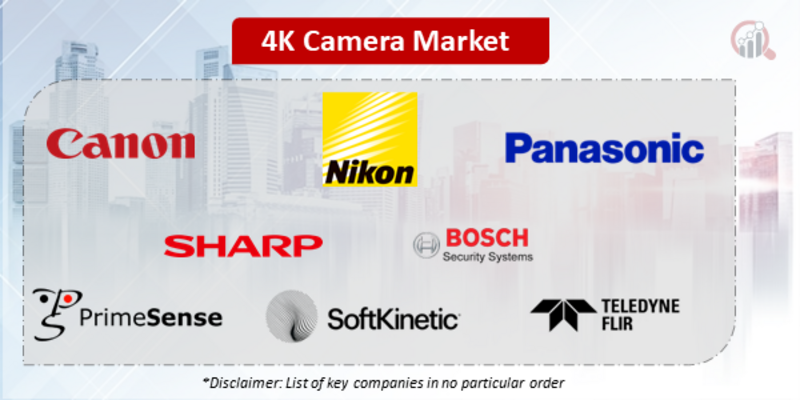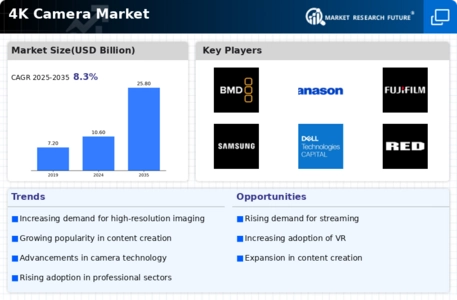Top Industry Leaders in the 4K Camera Market

Competitive Landscape of the 4K Camera Market:
The 4K camera market, driven by the insatiable appetite for high-resolution visual experiences, presents a dynamic and evolving landscape. Established giants clash with nimble innovators, while technological advancements and shifting consumer preferences constantly reshape the competitive terrain. Understanding this intricate interplay is crucial for any player seeking to thrive in this burgeoning space.
Some of the 4K Camera companies listed below:
- Canon
- Nikon
- Panasonic Corporation
- SharpCorp
- Primesense
- Softkinetic
- Bosch Security Systems
- FLIR Systems
Strategies Adopted by Key Players:
Canon, Sony, Panasonic, and Nikon are household names in the professional camera segment, leveraging their extensive experience and robust product portfolios. Canon's EOS C70 and C300 Mark III cater to filmmakers, while Sony's Alpha 7 IV and FX6 offer hybrid functionality for photographers and videographers. Panasonic's Lumix S5 II and GH6 appeal to content creators with their compact form factors and advanced video features. Nikon, though facing challenges, retains a loyal user base with its Z9 full-frame mirrorless camera.
These established players adopt diverse strategies. Canon and Nikon emphasize after-sales support and professional service networks, while Sony invests heavily in sensor technology and video capabilities. Panasonic focuses on niche markets like vlogging and live streaming with its GH series.
Market Segmentation and Share Analysis:
The 4K camera market can be segmented by product type (professional vs. consumer), application (film, broadcast, vlogging, etc.), and distribution channels (online vs. offline). Analyzing market share requires considering these segments, with factors like brand recognition, product features, pricing strategy, and regional presence playing vital roles.
New and Emerging Companies:
The market also witnesses the rise of new entrants like Blackmagic Design, Fujifilm, and RED Digital Cinema. Blackmagic Design's Pocket Cinema Camera 6K Pro targets filmmakers with its affordable price and RAW recording capabilities. Fujifilm's X-T5 and X-H2S offer compelling options for photographers and videographers with their unique sensor technology and fast autofocus systems. RED Digital Cinema remains a leader in high-end cinema cameras, catering to professional productions.
These newcomers often focus on specific features or niche markets to differentiate themselves. Blackmagic Design's emphasis on affordability and RAW capture appeals to budget-conscious filmmakers. Fujifilm's unique sensor technology and autofocus systems attract photographers seeking a distinct aesthetic. RED Digital Cinema's focus on high-end cinema cameras allows it to cater to a specific clientele.
Technological Trends and Market Disruption:
The 4K camera market is constantly evolving, fueled by technological advancements like artificial intelligence, image stabilization, and computational photography. AI-powered autofocus and subject tracking are becoming commonplace, while features like in-camera HDR and improved low-light performance are increasingly sought after.
Additionally, the rise of mirrorless cameras and smartphone photography poses challenges to traditional DSLR manufacturers. Mirrorless cameras offer smaller size and weight without sacrificing image quality, while smartphones continue to improve their camera capabilities, potentially impacting entry-level camera sales.
Latest Company Updates:
Canon:
- October 26, 2023: Canon unveils the EOS R8, a full-frame mirrorless camera with a 24MP sensor and 4K 60fps video recording.
- September 14, 2023: Canon releases firmware update 1.4.0 for the EOS R5 and R6 cameras, enabling 8K 30fps RAW recording and improved 4K 120fps recording.
- July 4, 2023: Canon introduces the EOS R7 and EOS R10 APS-C mirrorless cameras, both capable of 4K 30fps video recording.
Nikon:
- November 9, 2023: Nikon announces the development of the Z fc, a retro-styled APS-C mirrorless camera expected to offer 4K video recording.
- September 27, 2023: Nikon releases firmware update 2.0 for the Z9 full-frame mirrorless camera, enabling internal 8K 24fps RAW recording and improved 4K 120fps recording.
- July 27, 2023: Nikon launches the Z30 APS-C mirrorless camera, capable of 4K 30fps video recording.
Panasonic Corporation:
- November 1, 2023: Panasonic releases the Lumix S5 II full-frame mirrorless camera, offering 4K 60fps video recording with 10-bit internal sampling.
- September 7, 2023: Panasonic announces the development of the GH6 Pro, a Micro Four Thirds camera expected to offer 4K 120fps video recording.
- June 28, 2023: Panasonic introduces the Lumix GH6, a Micro Four Thirds camera capable of 5.7K 30fps and 4K 120fps video recording.
